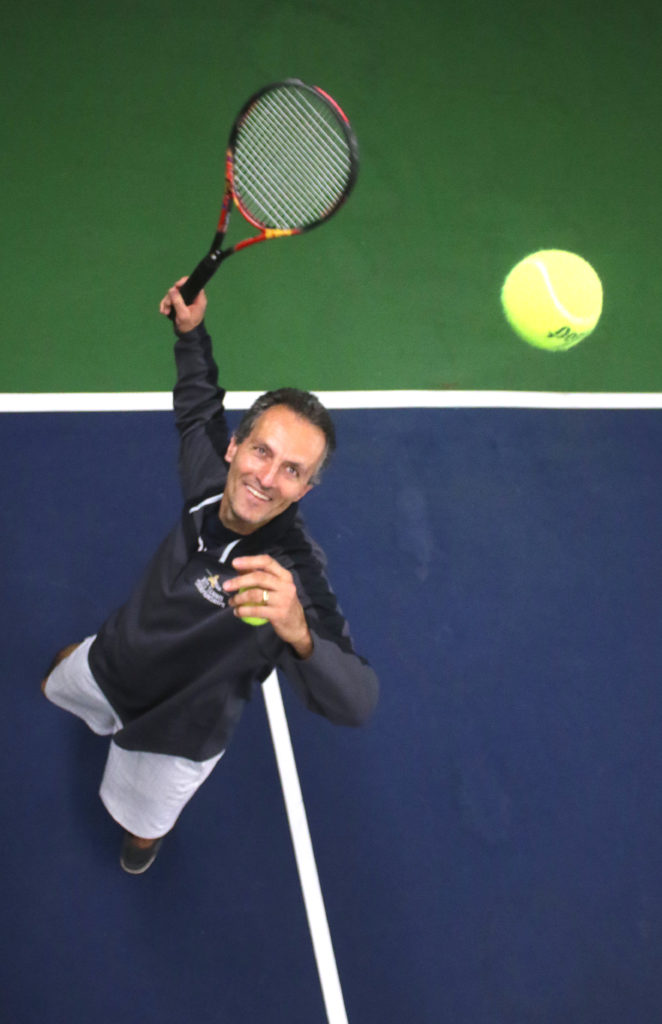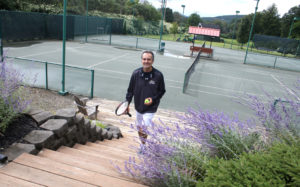FUNDRAISING UNDERWRITES LESSONS
Tennis Club Goes Private,
Aims To Train The Future
By JENNIFER HILL • Special to www.AllOTSEGO.com

ONEONTA – In 2017, Phyllis Orlowski discovered a worrisome trend in Oneonta in 2017: not many kids knew or were learning how to play tennis. There was no equipment, like racquets, balls and ball hoppers available and there was no motivation to even plat the sport.
In July, Oneonta High School’s Varsity Tennis coach, who commutes from Cooperstown, she began reversing that trend, running a three-week tennis camp on Wilber Park’s courts. Providing racquets, balls, and ball hoppers like those that can be seen here, many children wanted to participate. The 80 K-12 participants paid $10 each.
The United States Tennis Association’s Eastern Division was so impressed with Orlowski’s efforts, it declared her “Organizer of the Month” in August.
“It’s such an honor,” she said. “This is a really big deal that can help draw more attention and support for making tennis more accessible to children in the area.”
With its own membership declining, the Oneonta Tennis Club is seeking to replicate Orlowski’s success.
Last weekend, the club held a Charity Doubles Tournament to raise money for its new clinic for kids ages 5 to 10. The funds mean families will only pay $5 per child for a 45-minute lesson, taught by tennis pro Paul Catan.
“Tennis is expensive to learn – the lessons, equipment, entry fees for tournaments,” Catan said. “We’re trying to remove that barrier and make tennis accessible to more kids.”
Orlowski believed the decline in youth tennis began after City Hall stopped funding a summer tennis camp, which provided 10 weeks of free lessons to kids. But she didn’t realize the impact until 2017 when, after a nine-year hiatus, she returned to coaching OHS’ varsity team.

“I struggled to put together a competitive tennis team that year,” she said. “The kids didn’t know how to play tennis anymore. I had to do something.”
Young people need to be introduced to the game as early as possible, so they can play competitively by the time they entered high school, Orlowski said. If they start young then they will also have a passion for the sport that’s needed to put in the hours of training required. A young tennis player must be willing to visit sites comparing all the best racquets (learn more about this here) and train in their free time so they can get the advantage. But how to make it affordable?
Last year, “I reached out to Jenny Irwin, the head of the U.S. Tennis Association’s Eastern Division,” she said. “She told me about USTA grants I could apply for, so I applied for one and was awarded a $5,000 grant.”
Orlowski also found out about USTA’s youth tennis program, Net Generation, which “provides curricula and equipment tailored for all ages and abilities, so kids of all ages learn tennis skills and have fun doing it.”
“Net Generation hides skills in their lessons, so kids learn them without realizing it,” she said. “And they tailor it for different age groups.
“For instance, five year-old kids use large racquets and small red balls that don’t bounce much because they can’t even bounce a ball at that age.”
But Orlowski said it was Mary-Margaret Sohns, founder of the nonprofit Cooperstown Tennis, who made the Oneonta tennis summer camp happen.
“Mary-Margaret used Cooperstown Tennis to cover the required $1 million safety insurance camp,” said Orlowski. “Without that, we couldn’t have done the camp.”
Sohns “insisted the summer camp be taught by tennis pros, so she ‘donated’ Cooperstown Tennis’ instructors Jorge Falla and his son Sebastian, who are pros from Colombia.”
The Oneonta Tennis Club faces more challenges in funding affordable lessons, since it is a private, for-profit organization and the USTA only funds nonprofits’ and public schools’ tennis programs.
But Catan will begin teaching the youth clinics for 5- to 10-year-olds on Tuesdays, 3 to 3:45 p.m. And because the club has two indoor tennis courts – the only indoor courts in Otsego County – kids can learn and play tennis all winter long.
“There’s a real need out there for kids to just get the exposure to play tennis,” he said.

